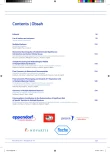Editorial (EN)
Published in:
Klin Onkol 2011; 24(Supplementum 1): 6
Category:
Editorial
Dear colleagues,
multiple myeloma is one of the main topics at the Olomouc Hematology Days 2011. Multiple myeloma (MM) is the second most common hematooncological disease. The Myeloma Section of the Czech Hematological Society and the Czech Myeloma Group have decided to prepare several interconnected activities; one of them is this Supplement in Klinicka onkologie, composed of a series of methodological papers from basic and applied research of MM and monoclonal gammopathies.
MM research development, as well as development of new treatment options, has been unprecedented in the first decade of this century. It is almost miraculous to observe how fast new knowledge has been transferred from applied research into clinics, the so-called bench to bed-side approach. In the area of basic research, development has been somewhat slower – a fact that is connected to the very nature of basic research and complicated oncogenesis of MM.
The first two introductory articles of this Supplement are summarizing current knowledge about MM and monoclonal gammopathy of undetermined significance (MGUS). After detection of light chains has been established, we have a clear proof that there is also Bence-Jones MGUS, or MGUS with free kappa and lambda chains that transform into MM of the same type. Another important idea to remember is the fact that there is possibly no MM occurring de novo, that all MM is preceded by MGUS as precancerosis. This has focused and accelerated research of MGUS oncogenesis as we know that it is a continuous long-term process. The importance of such research activities are increased by the fact that there are options that will effectively prolong transformation of MGUS or smoldering/asymptomatic MM into symptomatic MM requiring treatment.
Our methodologic papers reflect the current research potential of the Babak Research Institute. This research body, under the new name Babak Myeloma Group, has become part of the Department of Pathological Physiology, Faculty of Medicine of the Masaryk University and still concentrates on research of monoclonal gammopathies. This group is aimed at research of monoclonal gammopathies. Together with the University Hospital Brno, this group created a central biobank for research studies coordinated by the Czech Myeloma Group in central Europe, as well as several national and international research projects. The importance of preparation of defined population of MM or MGUS cells for experiments is presented in the paper by Potacova et al. focusing on separation methods, the key entry step for MM and MGUS research. Two papers are aimed at flowcytometric evaluation of clonal and physiological plasma cells (Kovarova et al.) and analysis of immunocompetent cells (Muthu Raja et al.) showing the major importance of flowcytometric analyses in MGUS. Currently, in the age of immunomodulatory drugs, there is heightened interest in immunoparesis in MM; based on several hypotheses, immunoparesis might not be the result but rather the cause of acceleration of MGUS into MM. Genomic and whole-genome methods are one of research approaches for MM research (Sevcikova et al., Smetana et al.) but the difficulty of these methods in MGUS is unprecedented. I am also glad that we have opened the gates to pharmacogenomics (Almasi et al.). It is just one way and it does not matter that clinically applicable outcome is still very problematic when deciding on risk for thrombosis in MM patients. Last two papers are aimed at methods used in our favorite research topics (nestin, centrosome).
I would like to thank all the authors of all publications, especially Mgr. Potacova, Ph.D., and Mgr. Sevcikova, Ph.D., for help with preparation of the manuscript.
I believe that you will find the papers interesting.
Prof. MUDr. Roman Hájek, CSc.
Chairman of Czech Myeloma Group
Head
of Babak Myeloma Group
Labels
Paediatric clinical oncology Surgery Clinical oncologyArticle was published in
Clinical Oncology

2011 Issue Supplementum 1
- Metamizole vs. Tramadol in Postoperative Analgesia
- Metamizole at a Glance and in Practice – Effective Non-Opioid Analgesic for All Ages
- Metamizole in perioperative treatment in children under 14 years – results of a questionnaire survey from practice
- Safety and Tolerance of Metamizole in Postoperative Analgesia in Children
- Obstacle Called Vasospasm: Which Solution Is Most Effective in Microsurgery and How to Pharmacologically Assist It?
Most read in this issue
- Multiple Myeloma
- Flow Cytometric Phenotyping and Analysis of T Regulatory Cells in Multiple Myeloma Patients
- Monoclonal Gammopathy of Undeterminated Significance: Introduction and Current Clinical Issues
- Flow Cytometry in Monoclonal Gammopathies
